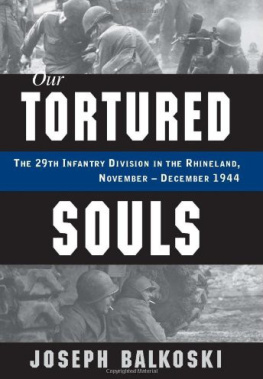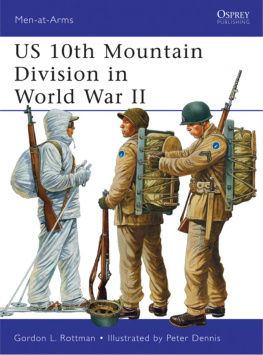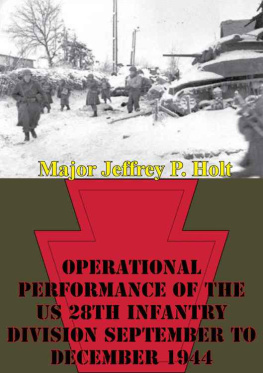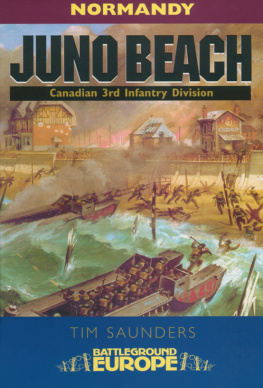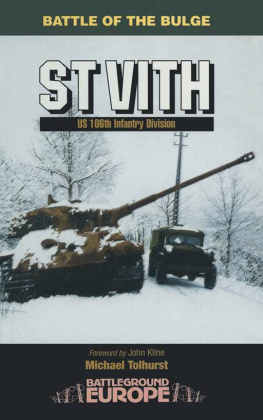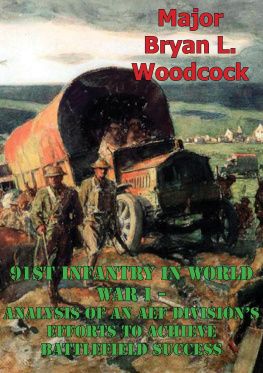FROM BRITTANY
TO THE REICH
The 29th Infantry Division in Germany,
SeptemberNovember 1944
Joseph Balkoski
STACKPOLE
BOOKS
Copyright 2012 by Joseph Balkoski
Published by
STACKPOLE BOOKS
5067 Ritter Road
Mechanicsburg, PA 17055
www.stackpolebooks.com
All rights reserved, including the right to reproduce this book or portions thereof in any form or by any means, electronic or mechanical, including photocopying, recording, or by any information storage and retrieval system, without permission in writing from the publisher. All inquiries should be addressed to Stackpole Books.
Printed in the United States of America
10 9 8 7 6 5 4 3 2 1
FIRST EDITION
Library of Congress Cataloging-in-Publication Data
Balkoski, Joseph.
From Brittany to the Reich : the 29th Infantry Division in Germany, SeptemberNovember 1944 / Joseph Balkoski.
pages cm
Includes bibliographical references and index.
ISBN 978-0-8117-1168-5
1. United States. Army. Infantry Division, 29th. 2. World War, 19391945Regimental historiesUnited States. 3. World War, 19391945CampaignsGermany. I. Title.
D769.329th .B35 2012
940.541273dc23
2012015910
eBook ISBN: 978-0-8117-4871-1
For
Melvin Sherr
104th Medical Battalion, 29th Infantry Division
19411945
Faithful soldier, devoted father, brilliant violinist, and loyal friend

Contents
Maps
Introduction 29, Lets Go!
F rom Brittany to the Reich is the third volume of what I anticipate will be a five-volume history of the 29th Infantry Division from its mobilization in February 1941 until its return to the States in January 1946. The first volume, Beyond the Beachhead, published in 1989 and updated in 2005, chronicles the divisions activities from its call-up at Maryland, Virginia, and District of Columbia National Guard armories through the end of the Normandy campaign in August 1944, including the monumental Omaha Beach invasion and the titanic battle for the key Norman cities of St. L and Vire. From Beachhead to Brittany relates the story of the 29th Divisions transfer from Normandy to the crucial Breton city of Brest, occupied by a formidable enemy garrison of more than 40,000 men, and whose massive harbor Generals Eisenhower and Bradley craved as an immediate solution to the Allies mounting logistical predicament in the aftermath of the Normandy breakout. The top brass expected Brest to be in Allied hands by the end of August. Instead, savage fighting endured until mid-September, by which time the situation on the Western Front had changed so profoundly that Eisenhower ultimately decided against restoring Brests devastated harbor.
In little more than three months of nearly continuous combat, the 14,000-man 29th Division had suffered close to 15,000 battle casualties, an unspeakable ordeal that completely turned over personnelin some cases two or three timesin nearly all of the divisions eighty-one rifle platoons, each comprised of forty-one men. Almost all of the 29th Divisions original Maryland and Virginia guardsmen had become casualties, their places filled by thousands of anxious and lonely replacements who knew little about the 29th and even less about their new comrades-in-arms. In a matter of days at the front, those replacements quickly discovered the implicit truth in the muttering of shell-shocked veterans: over time, and short of final victory, all riflemen would eventually be removed from the front line on a stretcher. The lucky ones would still be breathing, recipients of tender care from medics and rear-echelon doctors and nurses; the unlucky ones would be dead, cared for not by doctors and nurses, but by graves registration personnel.
Why five volumes to recount the history of just one of nearly one hundred U.S. Army and Marine Corps divisions that participated in World War II, especially one whose period in combat endured only eleven months? The immediate answer to that question is that such a comprehensive story is a fitting and valuable acknowledgment of the service of all of the American divisions that waged war against ruthless enemies from 1942 to 1945. True, my narrative may cover only a single unit, but the descriptions of battle and life out of the line should be familiar to all who served in ground combat units in World War II, particularly those members of the many storied divisions that bore the brunt of the fighting in the European and Mediterranean theaters from the November 1942 invasion of North Africa until V-E Day in May 1945.
The 29th Divisions harrowing combat period was obviously not unique. Indeed, it is astonishing to note that the 32,000 battle deaths suffered by only seven U.S. Army unitsthe 1st, 3rd, 4th, 9th, 29th, 45th, and 90th Infantry Divisionsamounted to 11 percent of the 291,000 Americans killed in action throughout World War II in all branches of military service, despite the fact that at any given time, those seven divisions totaled fewer than 100,000 men and represented but a tiny fraction of the nearly 12 million American men in uniform in 1944. If there is one prevailing theme to the 29th Divisions story, therefore, it is that ordinary American riflementhe pitiable dogfacescarried America to victory in World War II and, in so doing, suffered an inordinate quantity of casualties in relation to their number as a whole. That story is at once inspirational and extraordinarily sobering.
In a more personal sense, when I first interacted with 29th Division veterans more than thirty years ago, I was profoundly touched from the start by the realization that I had been drawn into the same sort of poignant human history that had entranced me in my youth during exploration of battlefields alongside my long-suffering parents during the Civil War centennial. Out of the bonds forged with 29th Division veterans over many years, there emerged a rare opportunity any good historian would gladly accept, one that I was privileged to stumble upon. Assuming I possessed the requisite patience and persistenceand I harbored acute doubt that I didthat chance could eventually yield not only a detailed chronicle of American men at war that would contribute materially to our understanding of U.S. Army combat operations in World War II, but also relate a story that the ex-warriors themselves for the most part had refrained from articulating after the war, either to family or friends, for fear of receiving an uncomprehending or unsympathetic audience.
Just as important as my enduring friendships with countless 29ers across three decades was my introduction to, and later management of, the Maryland National Guards marvelous collection of original 29th Division records and photographs held in the Fifth Regiment Armory in Baltimore. For more than a quarter of a century, I have benefited immeasurably from having the freedom to study and learn at my leisure from this priceless archive, and when ultimately the State of Maryland Military Department hired me as a historian to preserve, catalogue, and enhance that collection, I benefited still more. It was both chilling and thrilling to hold responsibility for the 29th Divisions official papers, brought home in their entirety in 1946 by the diligent Lt. Col. William Witte, the 29ths wartime operations officer. Most of these documents had lain unexamined in boxes for decades. Over time, this collection has been significantly augmented with daily morning reports from almost every 29th Division company or battery; unpublished memoirs of more than a hundred 29ers; a voluminous collection of my correspondence with and biographical information on some 1,600 members of the division; and rare combat film footage of 29th Division troops during World War II. Supplementing all of these precious historical resources has been the undeniably spellbinding work environment of the Fifth Regiment Armory, in which one can perform research while sitting in the same room as invaluable 29th Division artifacts, such as General Gerhardts jeep,



